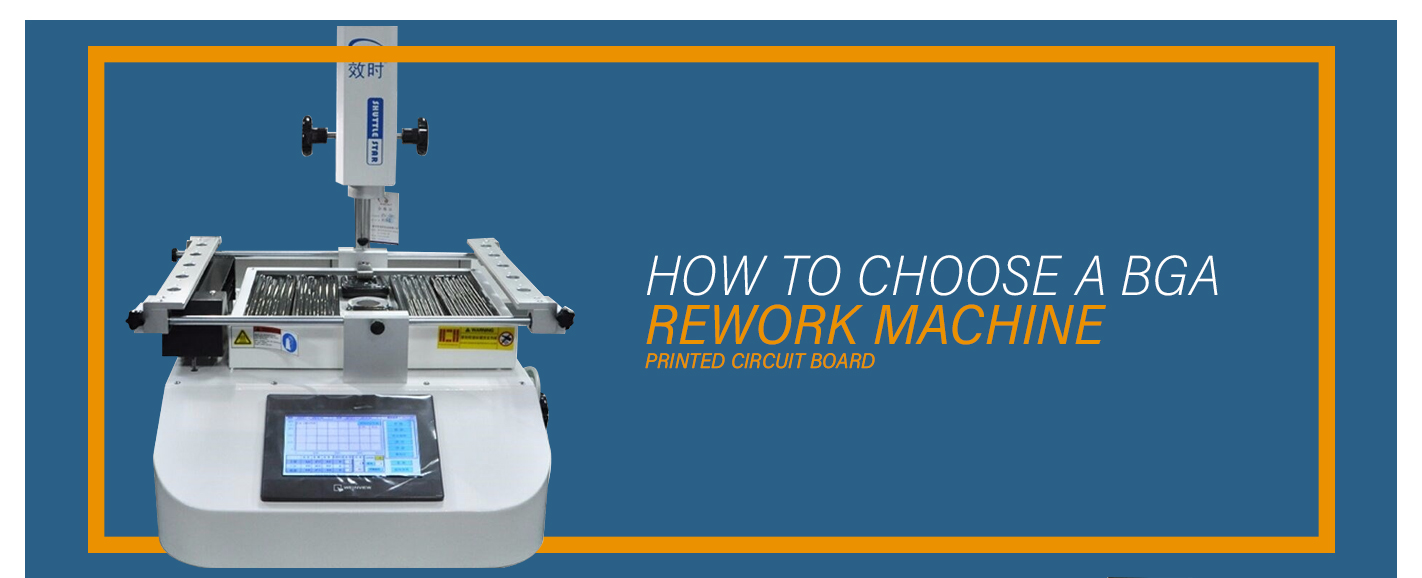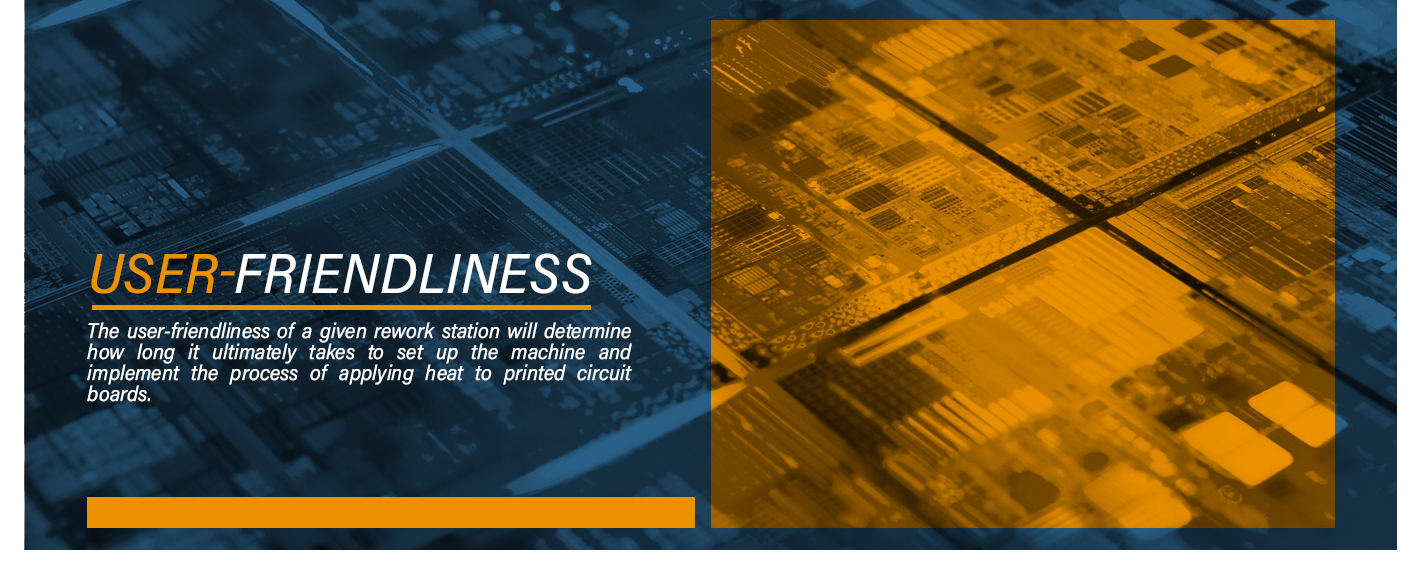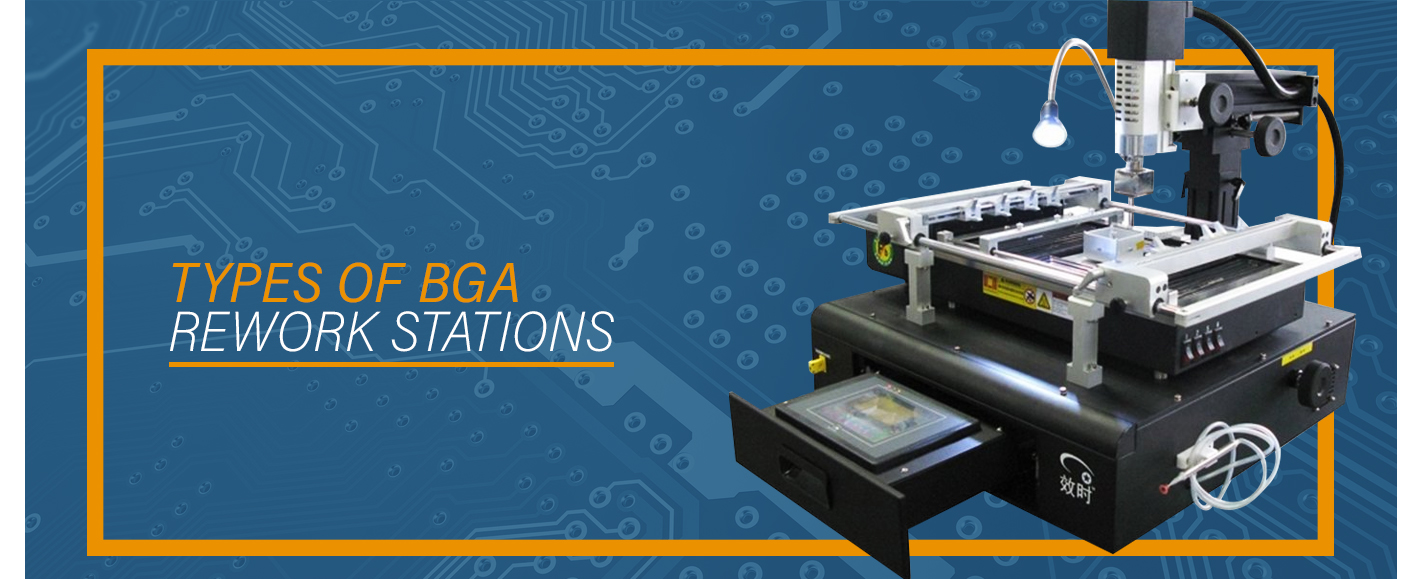How to Choose a BGA Rework Machine

A rework is the finished result of a printed circuit board (PCB) that has been desoldered and resoldered. The processes and techniques employed to make all this happen are known as "reworking." Whereas new PCBs are mass produced, a faulty board must be repaired individually. Technicians who are skilled in board repair will often employ manual techniques, some of which involve the use of heated air guns.
In cases where the ball grid array (BGA) needs to be repaired, the board will usually need to be heated to remove faulty parts and replace them with new ones. These steps are performed in a BGA rework station, which is a device designed and equipped for heating printed circuit boards to remove and replace malfunctioning parts.
When a PCB is submitted to a rework station, the process will typically cover several BGA components, each of which must be corrected individually. Shielding equipment is often necessary to isolate the BGA and protect the surrounding areas on a board, otherwise, the PCB could end up damaged. The parts of the board that are not subject to any work need to be blocked from heat exposure. To prevent the possibility of board contractions, thermal stress is kept to a minimum.
Various PCB defects can be corrected in a rework machine, including the following:
- Components that fail to work properly
- Faulty joints caused by thermal cycling
- Solder bridges between points that need to be kept separate
- Outdated parts that need to be adjusted to accommodate system upgrades
Types of BGA Rework Stations
There are two basic kinds of rework stations for BGAs — hot air and infrared ray (IR). What sets these apart from one another is the way they heat a PCB.
As their name suggests, hot air rework stations heat PCBs with hot air. Nozzles of varying diameter direct hot air on the areas of a circuit board that need repairs.
Infrared ray stations use infrared heat lights or precision beams to heat PCBs. IR rework machines in the low- to mid-price range often use ceramic heaters and use louvers to isolate the areas of focus on a printed circuit board. The best IR rework stations are those in the upper price range that use focus beams, as these do a better job isolating the BGA without causing heat damage to surrounding areas. The beam can be focused on different areas with varying scope and intensity. If you need the beam to be larger on one spot and smaller on another, it can easily be done with a focus beam IR rework station.
Both types of rework stations have their advantages and disadvantages. To determine whether the hot air or IR is the best for your company, you must take the features of both into account and consider how each would function in your working environment.
Key Features to Consider When Buying a BGA Rework Station
For the basic machine operator, there are several key features to consider when trying to find the best BGA rework station. The differences in performance between hot air and IR rework stations can make a huge difference in a given working environment:1. Temperature Control
The rework stations with the most user-friendly designs are those that come equipped with precision heaters at the top and bottom. With this design, you can keep the temperature consistent along both ends of the PCB. Hot air rework stations will typically employ focused heated air on the top and an unfocused board heater for the lower portion of the heating area. The flow of air will heat over the BGA and under the board as well. The bottom part of the heating compartment will consist of either a plate heater or an infrared light heater. On certain models, the plate will be equipped with holes that allow for the passage of heated air. If the area that you intend to heat is small, you may need to place the area directly above one of the holes in the plate from which heat emits. It might even be necessary to mark the spot where the PCB has been placed. If the hole and the spot are not properly aligned, the solder could be warmed to the wrong temperature. Additionally, rework stations should be equipped with a software program for setting temperatures and adjusting the temperature for each of the heaters to the exact degrees necessary for the project at hand. If properly designed, the rework station will calibrate the software temperature setting and the temperature of the heat that comes forth from the nozzle. The main problem is that the underside air is unfocused, which makes it difficult to guarantee an even spread of heat between the top and bottom of a given board. Without any feature that will focus the air along the bottom of the PCB, you might need to manually adjust the temperature along the underside of the heating compartment. The underside heaters on IR rework station models are designed with no bottom-side focus for the heated air. Some IR rework stations use a heat light equipped with a black diffuser that makes it easier to heat the circuit board evenly from one end to the other. Due to the inability for the software to calibrate with the heat on the infrared under-heater, there can be a temperature variance as wide as 100° C in certain units. On certain models, the software will not even allow you to set the heat in degrees. Instead, you are only allowed to set the heat in percentages, which can make settings even more difficult to set properly. You may need to place thermocouples on the printed circuit board and check the temperatures frequently. As you first get the process down, some of the chips are liable to wind up fried.2. Sound
Hot air BGAs apply air with a pump. Consequently, hot air rework stations typically produce some degree of noise. Newer models are usually equipped with quieter pumps, though the sound issue is still a factor that you must accept if you use this type of rework station. IR stations usually produce no noise at all. If you need to limit the amount of noise that comes from your rework machine, an IR station would be the better option. Noise can be an issue in certain settings, especially if there are already several loud machines going at once.3. Efficiency
Hot air rework stations are equipped with nozzles that make it easier for users to focus the flow of air on different areas of a printed circuit board. When the process is conducted by a skilled set of hands, the task can often be completed sooner with a hot air BGA because such units make it easy to isolate the more delicate details that can be hard to heat. With a focus beam IR, you do not need to buy heat nozzles of different sizes, since each beam can refocus at your command. However, it will often take longer to bring more delicate details to the desired temperature. Sometimes the IR beam cannot heat the lighter details on a ball grid array. A particular problem area with IR beams are the silver spots on a BGA, which often need black tape to bring them to the necessary temperature. Additionally, your success rate with a rework machine will all depend on whether the unit is sufficient for the volume of reworks you hope to achieve in a given day. The best BGA rework station for high volume work will generally be of the heated air variety. A hot air station makes it easier to heat the solder and complete the job sooner.4. Maintenance
Hot air machines have more parts and accessories since you need different sized nozzles. This can make them more complicated to repair and maintain. IR BGAs consist of fewer complex parts, which allows for less complicated maintenance and repairs. On the downside, these units run the gamut in terms of quality, as some of the low-priced models are typically equipped with low-grade parts that offer subpar performance. When it comes time to perform a more complex set of tasks with a lower grade IR rework station, extra tools will often be required. You should also consider the frequency at which maintenance is liable to be necessary for the respective unit. If a rework station consists of numerous complicated parts, the likelihood of a breakdown could be a real and costly threat. If the rework machine consists of a minimum of parts yet offers excellent results, you have probably found the best rework station.5. Cooling Time
Another important feature on a reworking station is an automatic cooling fan. With this feature, the printed circuit board and each of the heaters in the machine will all be cooled when necessary. As you work on one PCB after another, the unit will automatically cool as needed between each board. A cooling fan is essential for project efficiency on most reworking stations, which tend to cool slowly between applications. BGA machines that use drilled metal plates can take especially long to cool.6. PCB Specs
The size and sensitivity of your boards can also affect which type of rework station is best for your operations. Some machines can hold boards up to 36 inches. The space within the heater should accommodate the circuit board well enough to bring the entire PCB up to 150° C. This should help offset any possible warping effects. The age of your boards may also affect which machine is best. Over the past two decades, lead-free soldering has become the new standard in manufacturing. Consequently, reworking requires higher temperatures on newer printed circuit boards. On older PCBs, less heat was required for reworking because tin-lead solder melts at lower temperatures. If you work primarily with newer PCBs, you may need a more powerful station that can achieve higher temperatures.7. User-Friendliness
 The user-friendliness of a given rework station will determine how long it ultimately takes to set up the machine and implement the process of applying heat to printed circuit boards. A user's ability to correctly warm the PCB without causing damage to the board will sometimes depend on the design of the rework station. During the reworking process, the point is to retrace the steps that were employed during the original creation of the PCB and reapply those steps to make a new and improved board.
Your preference for one type of reworking machine over another will ultimately depend on the needs of your operation and the capabilities of your staff. The continued popularity of hot air units is due in large part to the fact that most of today's technicians learned how to do reworking on these machines. Therefore, IR stations are purchased by fewer facilities because the implementation of such units would require costly and time-consuming staff retraining.
Questions? Contact Us
The user-friendliness of a given rework station will determine how long it ultimately takes to set up the machine and implement the process of applying heat to printed circuit boards. A user's ability to correctly warm the PCB without causing damage to the board will sometimes depend on the design of the rework station. During the reworking process, the point is to retrace the steps that were employed during the original creation of the PCB and reapply those steps to make a new and improved board.
Your preference for one type of reworking machine over another will ultimately depend on the needs of your operation and the capabilities of your staff. The continued popularity of hot air units is due in large part to the fact that most of today's technicians learned how to do reworking on these machines. Therefore, IR stations are purchased by fewer facilities because the implementation of such units would require costly and time-consuming staff retraining.
Questions? Contact Us
Use Precision PCB Services
 Through every stage of the manufacturing process, it is crucial to have a facility that allows you to work efficiently with the barest minimum of downtime. At Precision PCB Services, our products have been used by product developers, electronic manufacturers, silicon chip manufacturers and technicians in the medical and aerospace sectors. With our services, manufacturers enjoy top-quality performance from the products they use.
At Precision PCB Services, we sell rework equipment that makes it possible for you to salvage your circuit boards and eliminate waste. Our rework stations are easy to set up and put into action. Many of them are ready to be plugged in and used with no set-up needed. With our training and tech support, any basic machine operator can make the equipment work on almost any PCB.
Precision PCB Services helps other businesses pinpoint defects in their manufacturing processes. From there, we help businesses rectify matters and implement strategies for more efficient results with our equipment. The equipment we sell is backed with lifetime technical support. Moreover, our BGA rework stations are backed with a one-year parts warranty.
To learn more about our products and services, request a free quote from Precision PCB Services and look at our BGA rework stations.
Through every stage of the manufacturing process, it is crucial to have a facility that allows you to work efficiently with the barest minimum of downtime. At Precision PCB Services, our products have been used by product developers, electronic manufacturers, silicon chip manufacturers and technicians in the medical and aerospace sectors. With our services, manufacturers enjoy top-quality performance from the products they use.
At Precision PCB Services, we sell rework equipment that makes it possible for you to salvage your circuit boards and eliminate waste. Our rework stations are easy to set up and put into action. Many of them are ready to be plugged in and used with no set-up needed. With our training and tech support, any basic machine operator can make the equipment work on almost any PCB.
Precision PCB Services helps other businesses pinpoint defects in their manufacturing processes. From there, we help businesses rectify matters and implement strategies for more efficient results with our equipment. The equipment we sell is backed with lifetime technical support. Moreover, our BGA rework stations are backed with a one-year parts warranty.
To learn more about our products and services, request a free quote from Precision PCB Services and look at our BGA rework stations.Bottom Line: Which Is Best?
Many hot air and IR BGA rework stations are available today, each of which has a different price point and feature set. This is an older and more established technology — one that we find offers better value for our customers.
Precision PCB Services exclusively sells hot air rework stations that are engineered for maximum performance in demanding applications. We select models for our product line that have all of the top features to allow for fast high yield BGA Rework while a the same time are easy to set up and train operators to use. Keep exploring our website to learn more.
